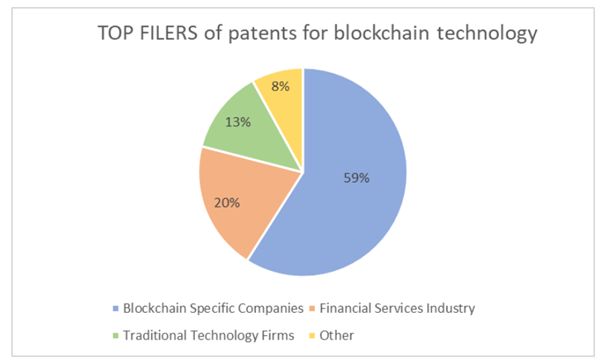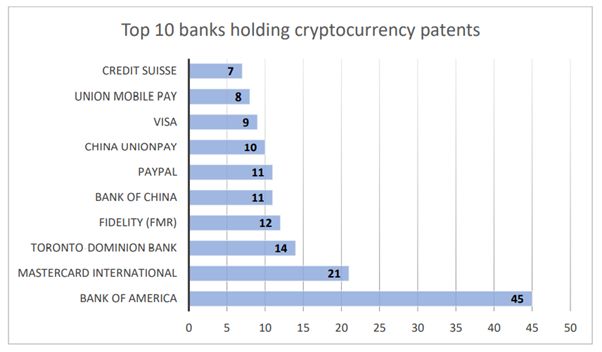Blockchain is the digital and decentralized ledger network that supports virtual currencies and is responsible for logging all transactions. The blockchain collects information pertaining to transaction and other relevant information together in groups, known as blocks, that hold sets of information. In another way, we can understand that the Blockchain is essentially an encrypted, public ledger of data that can be used to trade securely without intermediaries. The inception and growth of blockchain were established on the belief that the current banking system is inefficient and needs to be renovated. This technology can be comprehended in the innovation process and bring tremendous benefits to the patent system as well as copyrights, trade secrecy, defensive publications, and open innovation. It can help the inventors seize the value they invent by introducing the concepts of authenticity, condition, and ownership.
As blockchain is a disruptive technology, it is shaking up how financial institutions conventionally operate, and they are already investing in ways that they can evolve with the technology. In addition to the mix of financial institutions and tech companies, insurance companies also have an interest in blockchain technology especially as they leverage on blockchain's ability to make use of big data to target potential customers and streamline processes.
While the virtual currencies and establishments have a means to gain monetary profits by developing and marketing blockchain for enterprises, the intellectual property (IP) underlying the blockchain technology have the potential to become more valuable over the long run. Most importantly, now that the blockchain technology is in the public domain, significant variations and additions are being made in the blockchain technology which has applications in almost everywhere. As being in the public domain, many blockchain projects are open source and may not tend to seek patent protection. Therefore, the open-source aspect of many blockchain-based innovations leads to misconceptions about patents. The point being that if the blockchain technology-related patents are drafted appropriately, it will not limit to cover a single blockchain technology. Likewise, a patent can have a substantial value if it is chosen wisely and further covers fundamental functionality or features that become standard features of blockchain technology, something like having standard essential patent (SEPs) in blockchain domain. Hence, the patentability of software and technology platforms does not cease just because some or all the software is open source or built on a known protocol.
While looking at the patents filing statistics, one can notice that there is a boom in the patent filings related to Blockchain domain and this can be attributed to several reasons. According to the findings from incoPat, a technology analytics platform based in China, Chinese companies topped the list of 100 companies filing blockchain technology patents. The research data is based on global filing statistics of invention, design and utility patents from January 1, 2019 to December 31, 2020. Out of 100 companies, 53 were from China while US companies made up 34 of the 100. Alibaba topped the list with 244 patents/patent applications and was followed by Bank of America and the People's Bank of China's Digital Currency Research Institute with 129 patents/patent applications. Additionally, the data from the US Patent and Trademark Office (USPTO) database, indicates that there were 937 patent applications related broadly to blockchain technology published in 2018; 1520 patent applications published in 2019; 2730 patent applications published in 2020. As we can see, the steep rise in patent filings in blockchain domain in recent years which confirm and validate the need for protecting the blockchain related innovations.
Though the figures for the number of related patents being awarded were growing, according to the data, the grant rate of the patent applications has been declining. While in 2013 and 2014 most of the patent application were granted, patent applications in 2015 to 2017 only saw a roughly 50% chance of success, based on the number ultimately awarded. The data from recent years is not impressive to even talk about. The major issues in the grant rate for blockchain related patent applications can be attributed to the business method patents. Most of the patent applications being filed recently in blockchain technology related to business methods patents and that applicants should keep in mind whether the technical scheme is patentable depends on whether it has the technical problem and technical effects. As the technology is changing fast and is usually built on past models, the technical means should have inventiveness.
Let us also look at the number coming from WIPO patent database for the year 2018-2020. As shown below, 59 percent of the patents or applications were filed by "blockchain specific companies," meaning start-ups like cryptocurrency exchanges, whereas 8 percent of the patents or applications are filed by Others. Here, "Other" includes patent holding companies and companies in the IT and consulting services, gaming and retail industries.

Furthermore, the some more data available on WIPO patent database (year 2018-2020) indicates that the financial companies have overtaken the technology firms in seeking blockchain patents. Bank of America, a financial services company, has filed more blockchain related patents than any other company. Although, Bank of America may not be willing to help customers invest in Bitcoin, it is definitely paving its way into the blockchain technology underlying the cryptocurrency.

Throwing some more light on the blockchain technology, it is seen, from above statistics, that the use of the blockchain technology is not limited to the financial world and financial transactions, blockchain-based transactions are being leveraged by every industry. In view of this, let us look at some other aspects of blockchain technology:
DEPLOYING BLOCKCHAIN TECHNOLOGY WITHIN THE PATENT SYSTEM:
Implementing blockchain technology in Patent Office can work wonder. For example, the complete process of recording the filings of applications till the registration can be improved by reducing the inefficiencies in the docketing system. The entire solution can be built on top, providing a streamlined and transparent processes at the same time limiting inefficiencies, paperwork as well as potential corruption. More importantly, the technology could prove to be an effective tool to fight patent trolls, by offering companies a cheap and easy way to timestamp and create a trail of records for their inventions and trade secrets. The digital certificates based on blockchain can be used to defend against litigating NPEs as notarized arguments proving existence, ownership, and integrity for the prior use defence. Moreover, this could have substantial cost benefits by reducing the number of complex interactions with local and national governments. One decentralized ledger would also solve the problem of unifying the patent system across countries. This could vastly improve the effectiveness of IP management, speed up the innovation process in companies and foster the distribution of information across them through the ledger.
BLOCKCHAIN PATENT SHARING ALLIANCE:
A number of blockchain enterprises from USA, Canada and China have launched the Blockchain Patent Sharing Alliance (BPSA) at Stanford University to support, facilitate, and promote patent management through blockchain technology. More than 2500 blockchain-related patents have been created in the last three years. Due to its increasing momentum, there is a need for an entity like BPSA. The BPSA combines blockchain-related patents to form a patent pool, using the blockchain technology, with a view to unite blockchain patent owners, potential business users, and investors so as to build a patent-based intellectual property licensing and trading system.
The creation of the blockchain intellectual property rights trading platform will form a mutually beneficial and sharing patent platform, thus reducing the costs of blockchain patent writing, maintenance and application to safeguard the innovation of start-ups and the achievements of small-scale enterprises. This also helps promote the spread and application of blockchain technology in different industries. The primary object of BPSA is to establish a blockchain patent pool to achieve the mutual benefit of patents and promotion of technological exchange and sharing within the BPSA. It also aims to construct the patent sharing blockchain service platform and to build a patent index to show the growth in the value of the blockchain industry.
The BPSA provides high quality of blockchain patent and powerful blockchain technology strength as all the world's leading industrial alliances join in and due to the decentralized patent pool mechanism, the quality of patent pool improves. The BPSA provides for a built-in patent trading platform for capitalizing the intangible patent rights to generate intellectual property units for licensing, pricing, trading with smart contracts. In fact, the BPSA is independent of digital assets thereby increasing the liquidity of the IPR of patents. It provides for a transparent, fair and healthy patent system based on a high-tech core patent pool.
APPLICATION OF BLOCKCHAIN IN POSTAL SERVICES:
Blockchain not only enhances the complete security of a given organisation, but also supports adequate transparency and authentication wherever essential. Paradoxically, traditional postal services lack these elements. Amidst all of this, the Postal Services enabled by blockchain may also assist the governments in precise identity verification. The entire process of making transactions has become digital with the help of blockchain hence making the financial transactions inexpensive and secure. This will not only benefit the government but the end user as well. In the field of postal services, blockchain helps in keeping track of the mail. This technology can also be used to add a layer of security to the delivery of high value parcels, including luxury items. The application of the budding technology, i.e., the blockchain technology in postal services is extremely transparent, provides quick delivery of mails from one end to another and is highly secure.
APPLICATION OF BLOCKCHAIN IN PREVENTING COUNTERFEITING:
The blockchain based solution can be deployed to prevent the counterfeiting of the luxury products. The blockchain technology can map the manufacturer or supplier of the luxury goods/products with the end customer thereby preventing any option of counterfeiting.
CONCLUSION:
Author of the article while doing the research analyses many nuances of the technology and understand that the applications of blockchain technology have huge potential. It can certainly bring any platform on track and reduce the inefficiencies at the record speed. The research data derived from various sources indicates that the blockchain domain has huge potential and the filings in this technical field will continue to grow.
About the Author
Divyendu's extensive qualifications consist of graduation in Law with double bachelors in Mathematics and Computer Science, and Masters in Computer Engineering and Graph Theory.
Divyendu has vast experience in IP strategic advisory, patent drafting, prosecution and litigation. He has successfully handled and managed large IP projects for multiple national and international clients involving framing IP strategy and IP implementation framework, assisting clients to build their IP portfolios. In High Tech industry, he has handled a variety of issues including protection of software patents. His expertise includes advising on issues related to SEPs, technology standards and indemnification for Patent/IP-Infringement.
He has rich experience in technology deployment involving implementation of telecom, IT infrastructure, and software development. He regularly appears before various Patent Offices and Courts in matters relating to Patent prosecution and enforcement.
Specializations
- Patent-Advisory
- Patent-Drafting / Prosecution / Opposition / Invalidation / Portfolio Management
- Design-Advisory / Prosecution / Opposition / Rectification & Cancellation / Portfolio Management
- Plant Varieties Protection - Advisory / Prosecution / Portfolio Management
- Dispute-Resolution-IP & Commercial Litigation / Tribunals/
Arbitration & Mediation
- Transactions - Due Diligence / IP Audits & valuation / Licensing / Franchising & Merchandising / Technology Transfers
- Data Protection
- Antitrust & Competition Law
Divyendu is well-versed with the requirements and demands of both sides of the legal practice. His work includes, but is not limited to, drafting, prosecution and enforcement of Patent and Design rights, providing expert advice on Intellectual Property matters, entering negotiations and drafting a wide range of commercial contracts, advising on corporate governance and compliance issues.
Memberships:
- Member of the International Association for the Protection of Intellectual Property (AIPPI)
- Member of AIPPI Standing Committee on Information Technology & Internet
- Member of American Intellectual Property Law Association (AIPLA)
- Member of Asian Patent Attorney Association, Japan (APAA)
- Member of International Trademark Association (INTA)
- Member of Licensing Executives Society India (LESI) and LES
- US-Canada
The content of this article is intended to provide a general guide to the subject matter. Specialist advice should be sought about your specific circumstances.

